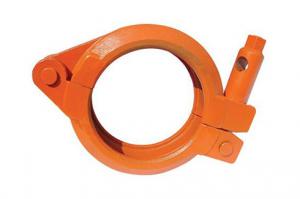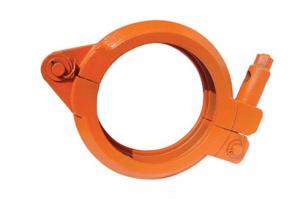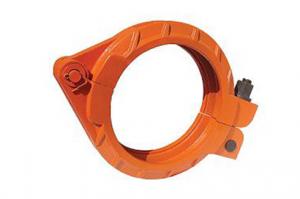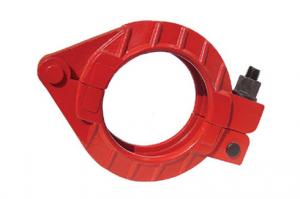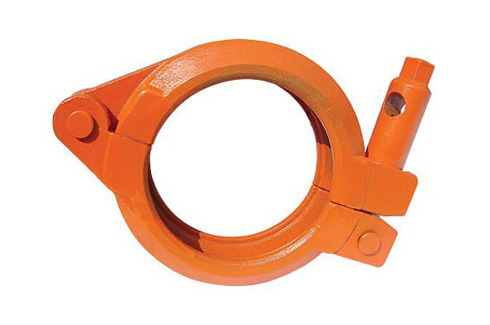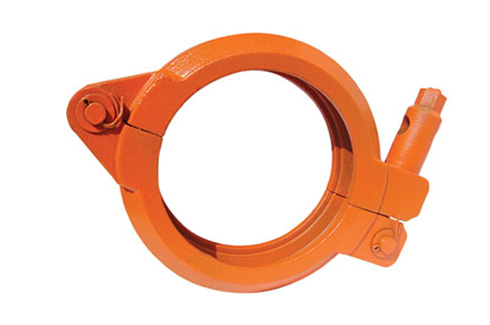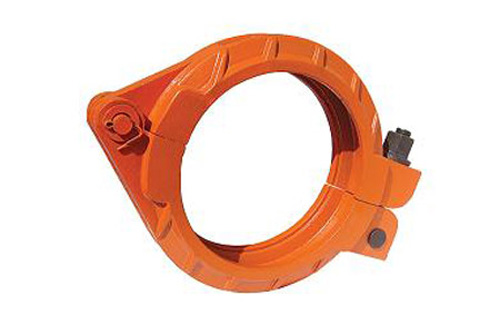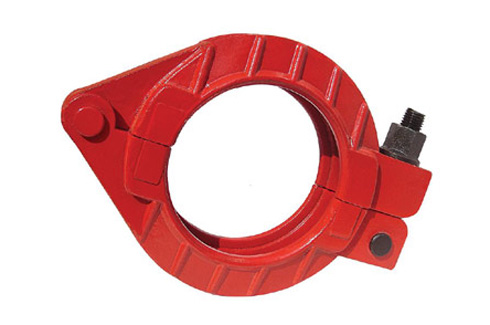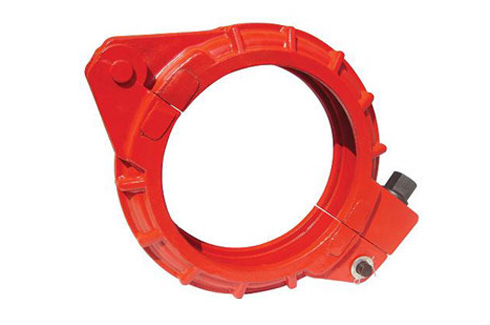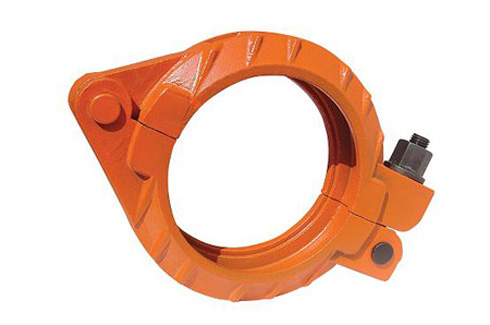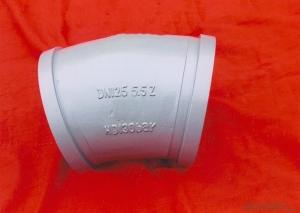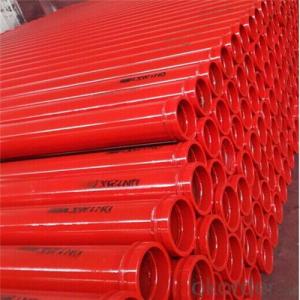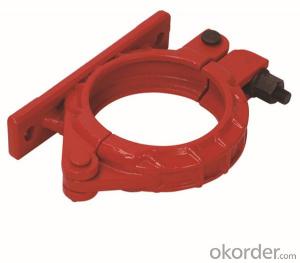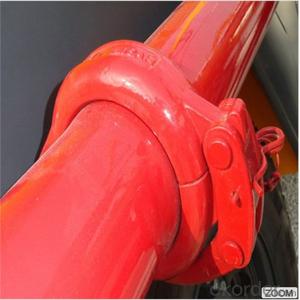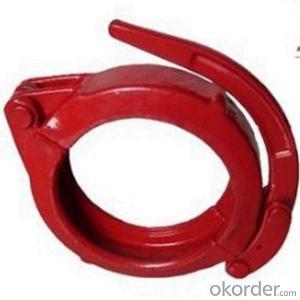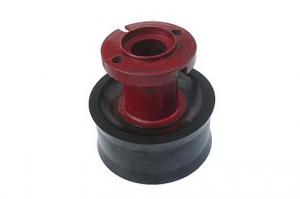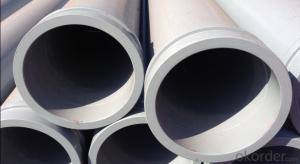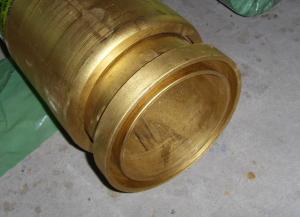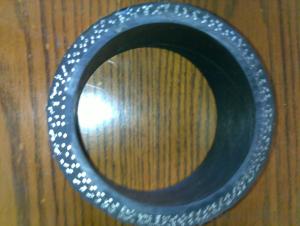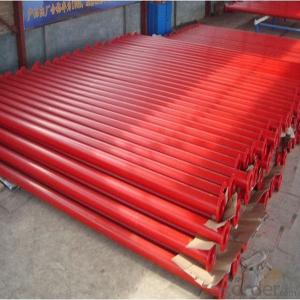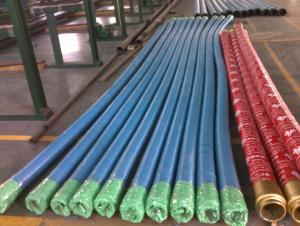Concrete Pump Parts Pipeline Coupling
- Loading Port:
- China Main Port
- Payment Terms:
- TT OR LC
- Min Order Qty:
- -
- Supply Capability:
- -
OKorder Service Pledge
Quality Product, Order Online Tracking, Timely Delivery
OKorder Financial Service
Credit Rating, Credit Services, Credit Purchasing
You Might Also Like
Size: 2"-8" (DN50-DN200)
Brand: Putzmeister, Schwing, Sany
Series: Screw Coupling, Bolt Coupling, SnapCoupling
Other products:
1) Putzmeister/ Schwing/ Zoomlion/ SermacRam Pistons
2) Putzmeister/ IHI/ Kyokuto/ Zoomlion/ SanySeperated Piston
3) Wear-resisting board and Cuts ink
4) Rubber hose
5) ST52 steel pipe, elbow, reducer
6) Cleaning seriesand others
- Q: Are there any specific guidelines for the installation of hydraulic filters or strainers in concrete pump spare parts?
- Yes, there are specific guidelines for the installation of hydraulic filters or strainers in concrete pump spare parts. 1. Size and Compatibility: Ensure that the hydraulic filter or strainer you are installing is the correct size and compatible with the specific make and model of the concrete pump. Using the wrong size or incompatible filter can result in poor filtration or damage to the hydraulic system. 2. Location: The filter or strainer should be installed in a location that allows for easy access and maintenance. It should be positioned in a way that allows for proper filtration of the hydraulic fluid without obstructing the flow. 3. Mounting: The filter or strainer should be securely mounted to prevent any movement or vibration during operation. It is important to follow the manufacturer's instructions for proper mounting techniques and torque specifications. 4. Orientation: Pay attention to the recommended orientation of the filter or strainer. Some filters have specific flow direction requirements, and installing them incorrectly can affect their performance and efficiency. 5. Protection: Consider installing additional protection, such as a guard or shield, to prevent damage to the filter or strainer from external factors like debris or impacts. This can help prolong the lifespan and effectiveness of the filter. 6. Maintenance: Regularly inspect and clean the filter or strainer to ensure proper functioning. Follow the manufacturer's recommended maintenance schedule and procedures for replacement or cleaning to maintain optimal filtration efficiency. It is important to consult the manufacturer's instructions and guidelines for the specific hydraulic filter or strainer being installed, as they may have specific recommendations or requirements unique to their product.
- Q: Are there any specific guidelines for the installation of wear plates or cutting rings in concrete pump spare parts?
- Yes, there are specific guidelines for the installation of wear plates and cutting rings in concrete pump spare parts. These guidelines are important to ensure the proper functioning and longevity of the pump. 1. Firstly, it is important to clean the surface where the wear plate and cutting ring will be installed. Any debris, dust, or old material should be removed to ensure a smooth and secure fit. 2. The wear plate and cutting ring should be inspected for any damage or defects before installation. Any parts that are worn out or damaged should be replaced to avoid any potential issues during operation. 3. Apply a thin layer of lubricant or grease to the surface where the wear plate and cutting ring will be installed. This will help with the alignment and ease of installation. 4. Carefully align the wear plate and cutting ring with the designated slots or grooves in the concrete pump. It is crucial to ensure that they are accurately positioned to avoid misalignment or premature wear. 5. Use appropriate tools or equipment to secure the wear plate and cutting ring in place. This may involve tightening bolts, screws, or other fasteners. It is important to follow the manufacturer's instructions and torque specifications to ensure proper installation. 6. After installation, perform a visual inspection to ensure that the wear plate and cutting ring are securely in place and properly aligned. Any signs of misalignment or loose parts should be addressed immediately. 7. Regular maintenance and inspection of the wear plates and cutting rings are essential to identify any signs of wear or damage. It is recommended to follow the manufacturer's recommendations for maintenance intervals and replacement schedules. By following these specific guidelines, you can ensure the proper installation and function of wear plates and cutting rings in concrete pump spare parts, leading to improved performance and extended lifespan of the equipment.
- Q: What is the purpose of a concrete pump carbide wear plate?
- The purpose of a concrete pump carbide wear plate is to provide a durable and long-lasting surface for the concrete pump to transfer the concrete from the hopper to the desired location. Concrete pumps operate by using a piston system to push the concrete through the pump and into the delivery line. During this process, the wear plate serves as a protective barrier against the abrasive nature of the concrete. Concrete is a mixture of various materials, including sand, gravel, cement, and water. As it is pushed through the pump, the abrasive particles in the concrete can cause significant damage to the internal components of the pump, leading to decreased efficiency and increased maintenance costs. The carbide wear plate is specifically designed to withstand the high pressures and abrasive forces encountered during the concrete pumping process. Made from a strong and durable material called carbide, the wear plate provides a resistant surface that minimizes wear and tear on the pump's internal components. By using a concrete pump carbide wear plate, contractors and construction professionals can ensure that their concrete pumps operate efficiently and effectively, with minimal downtime for repairs. This not only saves time and money but also ensures that the concrete is delivered smoothly and consistently to the desired location, resulting in high-quality construction projects.
- Q: What are the advantages of using carbon fiber components in concrete pump spare parts?
- There are several advantages of using carbon fiber components in concrete pump spare parts. Firstly, carbon fiber is extremely lightweight yet incredibly strong, which allows for reduced weight and increased durability of the spare parts. This not only makes them easier to handle and transport, but also enhances their overall performance and longevity. Secondly, carbon fiber has a high resistance to corrosion and chemicals, making it highly suitable for use in concrete pumping applications where exposure to various substances is common. This significantly extends the lifespan of the spare parts, reducing maintenance and replacement costs in the long run. Additionally, carbon fiber components offer improved fatigue and impact resistance, ensuring they can withstand the demanding conditions and high stresses involved in concrete pumping operations. This enhances the reliability and safety of the equipment, minimizing the risk of failure or breakdown during use. Furthermore, carbon fiber has excellent thermal and electrical insulation properties, reducing heat transfer and the risk of electrical conductivity. This makes it ideal for use in concrete pump spare parts that operate in extreme temperatures or are exposed to electrical currents, enhancing their overall performance and safety. In summary, the advantages of using carbon fiber components in concrete pump spare parts include lightweight yet strong construction, high resistance to corrosion and chemicals, improved fatigue and impact resistance, as well as enhanced thermal and electrical insulation properties.
- Q: Can I get spare parts for concrete pump hopper agitators and vibrators?
- Yes, you can get spare parts for concrete pump hopper agitators and vibrators.
- Q: How do concrete pump spare parts help in the pumping process?
- Concrete pump spare parts play a crucial role in the pumping process by ensuring the smooth and efficient operation of the concrete pump. These spare parts are designed to enhance the performance and longevity of the pump, ultimately leading to increased productivity and cost savings. One of the key advantages of using concrete pump spare parts is their ability to improve the overall pumping efficiency. These parts are manufactured with precision to maintain the optimal flow of concrete through the pump. For instance, the wear plate, wear ring, and S valve play a vital role in reducing friction and enhancing the pumping performance. By minimizing friction and maintaining a consistent flow, these spare parts prevent clogging and blockages, enabling the concrete to be pumped smoothly and efficiently. Furthermore, concrete pump spare parts are essential for minimizing downtime and maintenance costs. As the pump operates continuously, wear and tear are inevitable. However, regularly replacing worn-out parts with high-quality spare parts can significantly extend the lifespan of the pump and reduce the need for frequent repairs. By investing in durable and reliable spare parts, operators can avoid unexpected breakdowns and costly repairs, ensuring uninterrupted and efficient pumping operations. Moreover, concrete pump spare parts contribute to the safety of the pumping process. Components such as the safety valve, hopper grate, and control system play a critical role in preventing accidents and ensuring the well-being of the operators. These spare parts are designed to ensure the safe and controlled pumping of concrete, minimizing the risk of equipment failure and potential hazards. In conclusion, concrete pump spare parts are essential in the pumping process as they improve efficiency, reduce downtime and maintenance costs, and enhance safety. By investing in high-quality spare parts, operators can optimize the performance of the pump, increase productivity, and achieve cost savings in the long run.
- Q: Are there any online resources or manuals available for concrete pump spare parts?
- Indeed, the online realm offers a plethora of resources and manuals for concrete pump spare parts. Numerous manufacturers and suppliers of such components have established their own websites, which furnish comprehensive details concerning their products, encompassing manuals, catalogs, and technical specifications. It is worth noting that these websites often dedicate sections or pages specifically for spare parts, facilitating the acquisition of information pertaining to diverse types of spare parts, their compatibility with various pump models, and the process of ordering them. In addition to the aforementioned manufacturer websites, there exists a profusion of online marketplaces and directories that specialize in construction equipment and spare parts. These platforms empower users to conduct targeted searches for concrete pump spare parts, enabling the comparison of prices and specifications provided by different suppliers. Furthermore, some of these platforms offer supplementary resources, including user reviews, ratings, and guides to assist in selecting the appropriate spare parts for a given pump model. Moreover, online forums and communities cater to professionals in the construction industry, furnishing platforms for the exchange of information and discussions concerning concrete pumps and their spare parts. These forums serve as invaluable resources for obtaining recommendations, resolving common issues, and connecting with experts capable of offering guidance on sourcing and maintaining spare parts for concrete pumps. Overall, regardless of whether one is a concrete pump operator, maintenance technician, or an individual seeking spare parts for a concrete pump, the online domain abounds with resources that can provide the necessary information and manuals.
- Q: How can one source reliable suppliers for concrete pump spare parts?
- One can source reliable suppliers for concrete pump spare parts by conducting thorough research, seeking recommendations from industry professionals, checking customer reviews and ratings, and verifying the supplier's credibility and experience in the market. Additionally, attending trade shows and exhibitions related to the construction industry can provide opportunities to connect with reputable suppliers.
- Q: How to choose concrete pump?
- A concrete delivery pump has the following main technical parameters: conveying displacement, outlet pressure, motor power and distribution valve form.
- Q: What are the advantages of using OEM (Original Equipment Manufacturer) concrete pump spare parts?
- There are several advantages to using OEM (Original Equipment Manufacturer) concrete pump spare parts: 1. Quality Assurance: OEM spare parts are manufactured by the same company that produces the original equipment. This ensures that the parts are made to the same high-quality standards as the original components. The use of OEM parts guarantees that the concrete pump will perform at its optimal level and minimize the risk of breakdowns or failures. 2. Compatibility: OEM spare parts are specifically designed to fit perfectly with the original equipment. They are built to the exact specifications and dimensions required for seamless integration with the concrete pump. This compatibility ensures that the parts will function properly and efficiently. 3. Reliability: OEM spare parts are tested extensively by the manufacturer to ensure their reliability and durability. This means that they are less likely to fail or wear out prematurely, resulting in reduced downtime and maintenance costs. The reliability of OEM parts also minimizes the risk of accidents or injuries caused by faulty equipment. 4. Warranty Coverage: Many OEM spare parts come with a warranty from the manufacturer. This warranty provides protection against defects or failures, giving customers peace of mind and assurance that they are investing in high-quality components. In case of any issues, the manufacturer will typically provide support and assistance in resolving the problem. 5. Technical Support: OEM manufacturers typically offer technical support and assistance to customers using their spare parts. This support can be invaluable when it comes to troubleshooting issues, providing guidance on installation or maintenance, or offering advice on optimizing the performance of the concrete pump. This level of support may not be available when using non-OEM parts. 6. Long-Term Cost Savings: Although OEM spare parts may have a higher upfront cost compared to non-OEM alternatives, they often prove to be more cost-effective in the long run. Their superior quality and reliability result in fewer breakdowns, reduced maintenance expenses, and extended equipment lifespan. The use of OEM parts also helps to maintain the resale value of the concrete pump. In conclusion, the advantages of using OEM concrete pump spare parts include quality assurance, compatibility, reliability, warranty coverage, technical support, and long-term cost savings. By opting for OEM parts, users can ensure the smooth and efficient operation of their concrete pump while minimizing risks and maximizing the return on their investment.
Send your message to us
Concrete Pump Parts Pipeline Coupling
- Loading Port:
- China Main Port
- Payment Terms:
- TT OR LC
- Min Order Qty:
- -
- Supply Capability:
- -
OKorder Service Pledge
Quality Product, Order Online Tracking, Timely Delivery
OKorder Financial Service
Credit Rating, Credit Services, Credit Purchasing
Similar products
Hot products
Hot Searches
Related keywords
